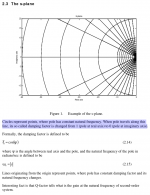Hello,
I am working on my theoretical skill, and I struggle a bit understanding the geometric interpretation of s-plane regarding eigenfrequency (natural frequency ?) and quality factor.
On this document (cf screenshot), I read that poles at constant frequency move on a circle when modifying the quality factor?
Is it because of this "natural frequency" term ?
It goes strongly against my intuition that constant frequency is equivalent to constant imaginary part of the pole.
http://jahonen.kapsi.fi/Audio/Papers/Equalization.pdf
I am understanding wrong ? is the document a bit inaccurate ?
Would you have some recommendation about resources I could use to understand those thing ? (signal theory, linear stuff, DSP, and so on). I am not too scared of maths, but I really enjoy pedagogical stuff that gives intuitions.
Thank you very much
I am working on my theoretical skill, and I struggle a bit understanding the geometric interpretation of s-plane regarding eigenfrequency (natural frequency ?) and quality factor.
On this document (cf screenshot), I read that poles at constant frequency move on a circle when modifying the quality factor?
Is it because of this "natural frequency" term ?
It goes strongly against my intuition that constant frequency is equivalent to constant imaginary part of the pole.
http://jahonen.kapsi.fi/Audio/Papers/Equalization.pdf
I am understanding wrong ? is the document a bit inaccurate ?
Would you have some recommendation about resources I could use to understand those thing ? (signal theory, linear stuff, DSP, and so on). I am not too scared of maths, but I really enjoy pedagogical stuff that gives intuitions.
Thank you very much
Attachments
I had to look up "natural frequency" to find its the same as resonant frequency. Thats the freq. an object vibrates when you hit it, or the freq where a circuit has max amplitude. It doesn't normally change so in that paper for any system the natural freq. Wn stays constant. The freq. of the signal w, is not constant. Its contained in the S as jw+rho.
If you want THE book, its here for free.
[PDF] Network Analysis and Synthesis By Franklin F. Kuo Book Free Download – EasyEngineering
If you want THE book, its here for free.
[PDF] Network Analysis and Synthesis By Franklin F. Kuo Book Free Download – EasyEngineering
Last edited:
For me, Norman Nise's textbook is the gold standard: amazon link
It covers stability (and instability) very thoroughly.
BTW the "natural frequency" omega sub 0, is seldom observed in real world physical systems, because real world systems contain nonzero amounts of damping. Instead, what is observed in real world systems is the "damped natural frequency" omega sub d
omega_d = omega_0 * sqrt(1 - (zeta squared))
where zeta is the damping factor. If for example an LC resonator contains any resistance R at all, then zeta>0 and omega_d < omega_0.
It covers stability (and instability) very thoroughly.
BTW the "natural frequency" omega sub 0, is seldom observed in real world physical systems, because real world systems contain nonzero amounts of damping. Instead, what is observed in real world systems is the "damped natural frequency" omega sub d
omega_d = omega_0 * sqrt(1 - (zeta squared))
where zeta is the damping factor. If for example an LC resonator contains any resistance R at all, then zeta>0 and omega_d < omega_0.
